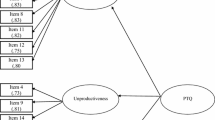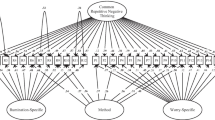Abstract
Repetitive negative thinking (RNT; e.g., rumination and worry) is a key-factor involved in the maintenance of emotional problems like depression and anxiety. Recently, the Perseverative Thinking Questionnaire (PTQ) was developed as a content-independent measure of RNT. The current study investigated the validity of this new measure in predicting depressive symptoms prospectively. Eighty-one students completed measures of depressive symptoms, depressive rumination and repetitive negative thinking. Depressive symptoms were re-assessed 3 years later (40 months follow-up). Results showed that repetitive negative thinking as measured by the PTQ predicts depressive symptoms at follow-up, even when taking into account baseline depressive symptoms and rumination. The results suggest that the PTQ has good (prospective) predictive validity for depressed mood and reconfirm RNT’s role in the course of emotional complaints.
Similar content being viewed by others
Notes
Given that scores on the rumination measure (RRS) and the PTQ measure were correlated, controlling for rumination may have induced spurious results. Therefore, all analyses were repeated without rumination scores in the analyses. Results remained the same, with PTQ-CF scores at T1 significantly predicting depression symptoms at T2, β = 0.43, p < 0.05; ΔR 2 = 0.10, p < 0.05; the same held for PTQ-Total scores, β = 0.31, p < 0.05; ΔR 2 = 0.07, p < 0.05.
References
Aldao, A., Nolen-Hoeksema, S., & Schweizer, S. (2010). Emotion-regulation strategies across psychopathology: A meta-analytic review. Clinical Psychology Review, 30, 217–237.
Beck, A. T., Steer, R. A., & Brown, G. K. (1996). Beck depression inventory (2nd ed.). San Antonio, TX: The Psychological Corporation.
Ehring, T., & Watkins, E. R. (2008). Repetitive negative thinking as a transdiagnostic process. International Journal of Cognitive Therapy, 1, 192–205.
Ehring, T., Zetsche, U., Weidacker, K., Wahl, K., Schönfeld, S., & Ehlers, A. (2011). The perseverative thinking questionnaire (PTQ): Validation of a content-independent measure of repetitive negative thinking. Journal of Behavior Therapy and Experimental Psychiatry, 42, 225–232.
Ehring, T. W. A., Raes, F., Weidacker, K., & Emmelkamp, P. M. G. (2012). Validation of the perseverative thinking questionnaire – Dutch version (PTQ-NL). European Journal of Psychological Assessment, 28, 102–108.
Harvey, A. G., Watkins, E. R., Mansell, W., & Shafran, R. (2004). Cognitive behavioural processes across disorders. Oxford, UK: Oxford University Press.
Nolen-Hoeksema, S., Larson, J., & Grayson, C. (1999). Explaining the gender difference in depressive symptoms. Journal of Personality and Social Psychology, 77, 1061–1072.
Raes, F., & Hermans, D. (2008). On the mediating role of subtypes of rumination in the relationship between childhood emotional abuse and depressed mood: Brooding vs. reflection. Depression & Anxiety, 25, 787–792.
Raes, F., Schoofs, H., Hoes, D., Hermans, D., Van Den Eede, F., & Franck, E. (2009). Reflection’ en ‘brooding’ als subtypes van rumineren: een herziening van de Ruminative Response Scale. [Reflection and brooding as subtypes of rumination: A revision of the Ruminative Response Scale]. Gedragstherapie, 42, 205–214.
Schoofs, H., Hermans, D., & Raes, F. (2010). Brooding and reflection as subtypes of rumination: Evidence from confirmatory factor analysis in nonclinical samples using the Dutch Ruminative Response Scale. Journal of Psychopathology and Behavioral Assessment, 32, 609–617.
Segal, Z. V., Williams, J. M. G., & Teasdale, J. D. (2002). Mindfulness-based cognitive therapy for depression: A new approach for preventing relapse. New York: Guilford Press.
Treynor, W., Gonzalez, R., & Nolen-Hoeksema, S. (2003). Rumination reconsidered: A psychometric analysis. Cognitive Therapy and Research, 27, 247–259.
Van der Does, A. J. W. (2002). Manual of the Dutch version of the BDI-II. San Antonio, TX/Lisse, the Netherlands: The Psychological Corporation/Swets Test Publishers.
Watkins, E. (2008). Constructive and unconstructive repetitive thought. Psychological Bulletin, 134, 163–206.
Wells, A. (1995). Metacognition and worry: A cognitive model of generalized anxiety disorder. Behavioural and Cognitive Psychotherapy, 23, 301–320.
Wells, A., & King, P. (2006). Metacognitive therapy for generalized anxiety disorder: An open trial. Journal of Behavior Therapy and Experimental Psychiatry, 37, 206–212.
Author information
Authors and Affiliations
Corresponding author
Additional information
Author Note
The writing of this paper was further supported by KU Leuven Center of Excellence on Generalization Research (GRIP*TT; PF/10/005).
Rights and permissions
About this article
Cite this article
Raes, F. Repetitive Negative Thinking Predicts Depressed Mood at 3-Year Follow-up in Students. J Psychopathol Behav Assess 34, 497–501 (2012). https://doi.org/10.1007/s10862-012-9295-4
Published:
Issue Date:
DOI: https://doi.org/10.1007/s10862-012-9295-4




